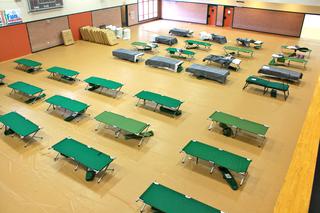Disaster Drills Test Unalaskans' Grace Under Pressure

Monday, March 31 2014
At 5:30 Friday morning, Unalaska was struck by a fake tsunami that damaged homes, roads, and docks. Phones went dead and rolling blackouts swept through town -- at least, hypothetically speaking. KUCB’s Lauren Rosenthal has more.
Right now, the Alaska Shield drill is still going on in some cities across the state. Communities are acting out a large earthquake and tsunami, so first responders can practice dealing with the fallout from a natural disaster.
In Unalaska, emergency workers -- and even volunteers, who were just helping out -- got a major workout.
William Cross: "We have 250 people estimate[d] displaced and we’ll be registering them. Some of them we’ll be housing through the night."
William Cross usually manages the city landfill. But during the tsunami simulation, Cross was in charge of a pop-up Red Cross shelter at the Department of Parks, Culture, and Recreation.
He and his volunteer staff had to sign in dozens of locals and make sure the they obeyed the shelter’s rules. That would have been a lot easier if it weren’t for Ben Bolock.
During the last drill, he ran the shelter, but this time:
Bolock: "What I am? I’m a controller. So I’m controlling these scenarios. So I’m not really involved with what they’re going to do."
Bolock lined up a string of community members to create problems in the shelter. He stood back and watched those so-called “scenarios” unfold:
Bolock: "Two people had huge knives coming down their legs."
LR: "Those kids?"
Bolock: "Yeah."
Shelter staff got wise to the trick. They stopped the young boys and offered to hold onto the hunting knives behind the counter while they toured the facility.
But not all of the scenarios were that easy to handle. Laura Leasure signed up to play the role of a confused elderly woman who lost her dog when the tsunami sirens went off.
Leasure: "And I can’t find him and I’m very upset about that, I’m very upset. So I have to go home -- already my heart’s starting to act funny. I’ve almost got myself in tears!"
Ben Bolock: "Don’t do that!"
Leasure: "So my heart’s acting up and I’ve got to have my medicine! I take it twice a day...How’s that?"
It was good enough that when Leasure walked into the shelter, volunteers swung into action. They found Leasure’s medicine -- an empty pill bottle she’d planted at home -- and they spread the word to find her lost dog.
While the shelter had their hands full dealing with the human side of the disaster, city officials were busy handling logistics.
At the police station, cops and municipal department heads gathered to form an emergency operations center. From there, they took stock of the fake tsunami damage, and coordinated their response to it.
Police chief Jamie Sunderland:
Sunderland: "Are search and rescue operations continuing? We probably need to check with operations on that. Does that continue? And if that is complete, we need to perform to some kind of security operation..."
That’s good practice for dealing with an ongoing natural disaster. But the ability to act fast is just as important for police and EMTs.
That’s why, after the earthquake drills ended, the police had to respond to their own fake scenarios: Locate a lost hiker was stranded at the bottom of a ridge, and recover the body of a possible suicide victim from a remote beach.
It might seem like a strange way to end a natural disaster drill, but disasters can take lots of forms. The safest way to prepare is to be ready for anything -- natural disasters and human ones, too.




janice krukoff on Monday, March 31 2014:
I wish I could have been a part of this drill, not only was it intensifying but watching the medical and police in force- doing a great job to help those in a disaster situation. Having volunteers such as victims of major disasters or those who played a role to be of assistance- takes creativity and aspiration! Unalaskan's you gotta be ready as it's only a matter of time- and when disaster strikes- we will feel it.